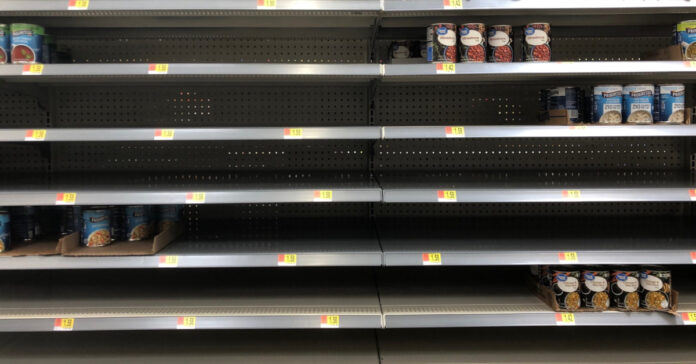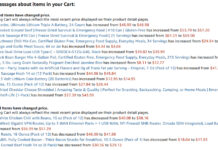
Until this spring, very few Americans can remember living through a period when there were empty shelves at the super market. Sure, maybe milk and bread sold out before a snow storm, or bottled water and batteries before a hurricane, but we always knew there would be more in a few days.
Thanks to the coronavirus and the subsequent shutdown of half of American’s economy, the shortage of paper products, cleansers and sanitizers, baking ingredients like flour and yeast, canned soups, fresh meat, guns and ammo, canning jars and lids, and sewing supplies was real and lasted for months. Many shortages started in March and persisted into the summer while others continue today. Shipping times from Amazon dropped from one or two days to weeks.
Shortages suck, not only because we can’t get things we need, but because the scarcity drives up prices. Just look at the ammunition market today where ammo that used to be $13.95 a box is now $49.95, if you can find the caliber you need. Food inflation has also hit, driving up the amount you spend at the grocery store.
Shortages that Never Really Went Away
While there’s usually toilet paper on the shelf these days, there are plenty of shortages that still exist, including:
- Guns and especially ammunition
- Canning lids and pressure canners
- Freezers
- Cars, both new and used
- Jobs – there are just too few of them these days, leaving many unemployed
Future potential shortages include:
- Drugs made in China or with ingredients made in China
- Food, from fresh food to pantry items and staples
- Christmas gifts and toys
- Sporting and leisure goods
- Lumber and do-it-yourself products
Shortages are Coming Back
We believe that we are coming to the end of a period of relatively plentiful goods on shelves and the months of November and December, the busy holiday shopping season will see things run out. We are predicting that empty shelves will be back, and the holes in inventory will include food, but far more items.
Here are some news articles that provide additional and in some cases very specific examples:
- The Pandemic Will make it Hard to Find These Foods this Fall from mashed.com, mentions baking staples, some carbonated beverages, snack foods and Spam. Spam maker Hormel “has 24 percent less inventory of all products than it did a year ago” and shortages could even impact availability of Skippy peanut butter.
- Supply Chain Issues Affect Items from Cars to Fishing Lures illustrates how smaller towns like Moscow, Idaho, common items are becoming scarce as big chains snap up the goods, leaving holes in local inventory. Christmas decorations and kid’s toys could be affected.
- Over at the Organic Prepper Blog, they report Food Shortages Hit China: There Is “not…enough fresh food to go around.” Food shortages in China will impact the world. Keep in mind that the U.S. is a large supplier of food to China and the Chinese own several large meat processing companies. That means food produced in the U.S. could be sent overseas instead of feeding us.
- “The ships are 100 full. The containers are 100% full. You can’t get a container build. You can’t pick up a ship from the sport market.” This is how the article Container Slots Sell Out, Risking Holiday ‘Shipageddon’ from American Shipper starts out. “There is rising concern that companies will not be able to import and deliver enough goods to meet consumer demand during the holiday season,” it says.
For more on looming food shortages and the global impact, check out iceagefarmer.com, especially his latest video:
How to Fight Shortages
The key to fighting shortages is to buy these items now while there is no shortage and store enough to last you through a future shortage. In other words, don’t wait until the last minute. Do your Christmas shopping now. Stock your pantry, your gun safe, your sewing basket, your medicine cabinet, and keep an eye out for anything you can’t find. If you normally shop at Walmart but can’t find an item, try Target your a grocery store. Shop online and look at the manufacturer’s web site. Don’t ignore small mom-and-pop stores, general stores and small merchants in your area. They may have inventory that would surprise you. Be persistent.
Take a look at your family’s consumption and habits to calculate what you nede to buy. Look in your cupboards and see what goes first. Check their closets and see what they will outgrow or wear out. (Think basics like socks and underwear.) Then go out and hit the stores. Don’t wait for the cold weather to hit to buy new thermal underwear. Don’t wait until your shoes wear out to buy a new pair. Get your favorite decongestant before you catch a cold. In other words, prepare for day-to-day life just as you would a serious prepping emergency.
Think worst-case scenario. What would happen if the vaccine doesn’t work or the coronavirus mutates? What would happen if containers of goods from China stopped arriving or if crops failed? Plan for these situations just as you would for that blizzard or hurricane.
If you think a shortage might last months, buy accordingly. If you think the changing global situation or political crisis could mean food shortages for years, then that may require more than stocking up; that may require a lifestyle change so you can raise your own food and small livestock.
You’ve been warned. Now do some research and make your plans accordingly. Your future rests in your hands; go into it with your eyes open.
If you enjoyed this article, you might like The Top 10 Things to Buy Before the Election.







